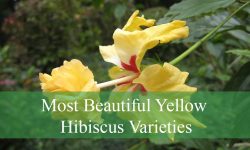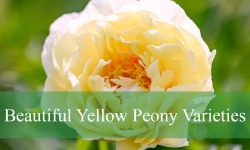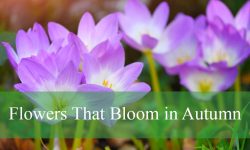Iris plants are some of the most captivating flowers in any garden. Known for their vibrant colors and unique shapes, these plants are a favorite among garden enthusiasts and landscapers alike. Whether you’re a seasoned gardener or just starting, learning about the different types of iris plants can help you choose the perfect variety for your garden’s aesthetic and climate.
There are numerous types of iris plants, each offering distinct beauty and charm. From the elegant tall bearded irises to the delicate crested irises, their diversity in color, size, and growth habits makes them suitable for various garden designs. In this article, we’ll explore 40 stunning types of iris plants, showcasing their beauty and providing insights into their ideal growing conditions.
If you’re looking to add a touch of elegance to your garden, exploring the wide array of types of iris plants is an excellent place to start. Whether you’re interested in classic purple varieties or rare, exotic colors, there’s an iris type that will perfectly complement your garden’s theme.
Different Types of Iris Plants
Iris ensata ‘Queen’s Tiara’
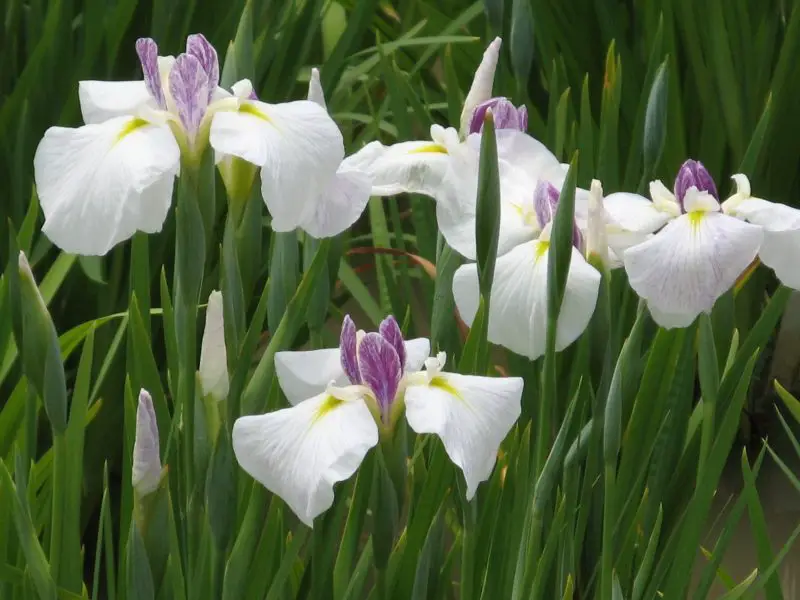
Iris ensata ‘Queen’s Tiara’ is a regal Japanese iris known for its large, papery white falls with intricate purple veining. The standards are a rich violet, creating a stunning contrast against the white falls. Each flower reaches up to 6 inches in width and has a bright yellow signal at its center.
Its foliage is thin, upright, and dark green, providing a striking backdrop for the elegant blooms. This iris should not be cut back until after the first frost, as its leaves store energy for the following season. The blooms are long-lasting in floral arrangements, making this variety a great choice for cutting gardens.
Grow Iris ensata ‘Queen’s Tiara’ in full to partial sun and keep the soil consistently moist. It thrives in USDA hardiness zones 4-9 and is an excellent choice for borders, pond edges, or rain gardens. Regular division will help maintain its vigor and ensure continued flowering.
Iris ensata ‘Flashing Koi’
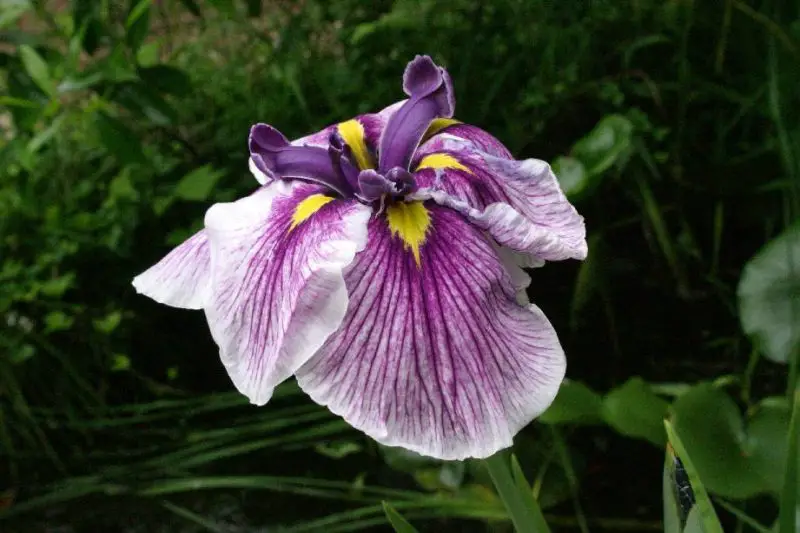
Iris ensata ‘Flashing Koi’ boasts flat, crepe-textured petals with dark plum centers that gradually fade into white edges. The flowers are large and striking, resembling the graceful movement of koi fish in water. A bright yellow signal in the center adds a final touch of brilliance.
Like most water-loving irises, this variety has strong, upright foliage that remains attractive throughout the growing season. The falls are broad and multicolored, while the standards are small and dark, creating an eye-catching contrast. This iris is a great choice for wet landscapes.
Iris ensata ‘Flashing Koi’ thrives in full to partial sun and tolerates damp soil, making it ideal for marshy areas or stream banks. However, it requires well-draining conditions in winter to prevent root rot. Hardy in zones 4-9, this variety is a great way to add texture and movement to the garden.
Iris ensata ‘Alpine Majesty’
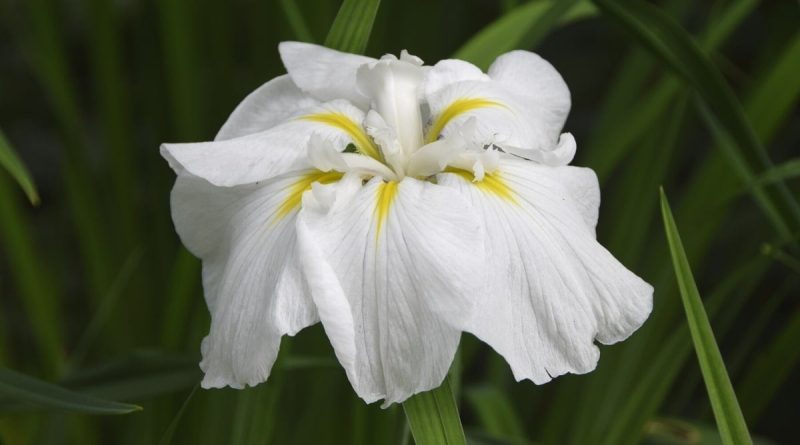
Large, double-white flowers that resemble freshly fallen snow distinguish Iris ensata ‘Alpine Majesty.’ The petals are thin and delicate, with visible veining adding texture. A sunny yellow throat streaks the midribs of the falls, creating a striking contrast against the pure white blooms.
The foliage of ‘Alpine Majesty’ is sage green and upright, with well-defined midribs that provide a unique texture. Like all Japanese irises, it thrives in moist, slightly acidic soil and prefers consistently damp conditions during the growing season.
For optimal growth, plant Iris ensata ‘Alpine Majesty’ in full to partial sun. It reaches heights of 3 to 4 feet and performs best in USDA hardiness zones 4-9. Regular division helps maintain its vigor and promotes abundant flowering year after year.
Iris germanica ‘Acapulco Gold’
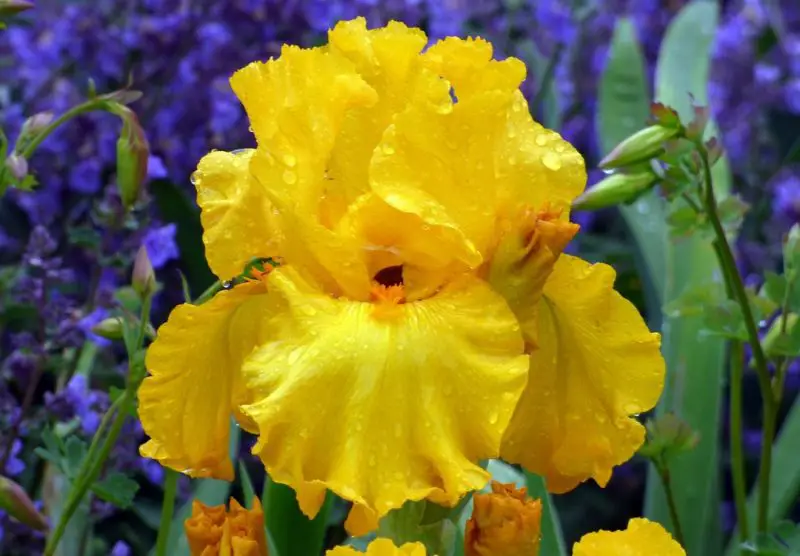
Iris germanica ‘Acapulco Gold’ produces intensely ruffled, golden-yellow blooms that stand out in any garden. The large, showy petals have subtle veining, adding depth to their rich color. Its beards, nearly the same shade of yellow, attract pollinators and enhance the flower’s beauty.
This bearded iris thrives in well-draining, neutral to alkaline soil and requires full sun to produce its best blooms. The sturdy, sword-like foliage remains upright and provides visual interest even when the flowers are not in bloom.
For optimal performance, plant Iris germanica ‘Acapulco Gold’ in a sunny location with good air circulation. It grows to a height of 2 to 3 feet and is hardy in zones 3-9. To prevent overcrowding, divide the clumps every 2-3 years.
Iris germanica ‘Above the Clouds’
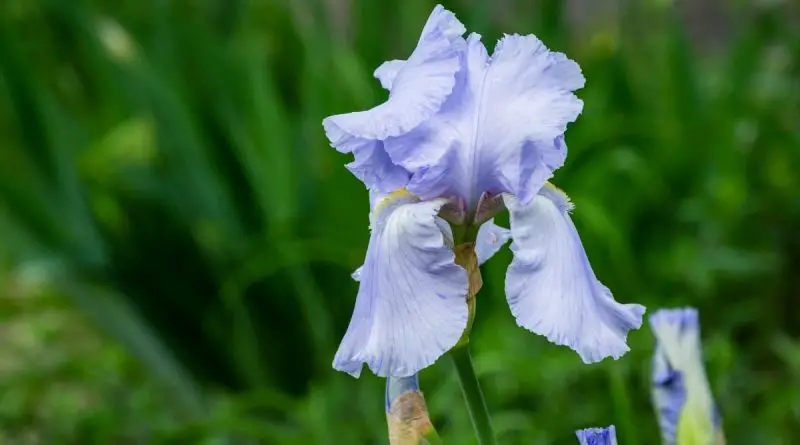
With its large, sky-blue blooms and deeper veining, Iris germanica ‘Above the Clouds’ is a striking addition to any landscape. The falls and standards are both heavily ruffled, giving the flower a voluminous, cloud-like appearance. Its bright yellow beards add contrast to the cool-toned petals.
The foliage is broad, sword-shaped, and blue-green in color, complementing the soft lavender-blue of the flowers. This variety thrives in sunny locations and adapts well to both garden beds and container plantings.
Plant Iris germanica ‘Above the Clouds’ in full sun with well-draining soil. It reaches heights of 2 to 3 feet and is best suited for USDA hardiness zones 3-9. A mass planting creates a breathtaking, airy effect in the garden.
Iris germanica ‘Before the Storm’
Iris germanica ‘Before the Storm’ is known for its dark, inky purple blooms that resemble storm clouds gathering in the sky. The petals are slightly ruffled and have violet-purple veining at the base of the falls. The black-purple beards blend seamlessly with the deep, moody tones of the petals.
This variety is prized not only for its dramatic coloration but also for its light, sweet fragrance. The long, sturdy stems reach up to 4 feet in height, making it one of the taller German irises. The thick, sage-green leaves provide lasting interest even after the flowers fade.
For best results, plant Iris germanica ‘Before the Storm’ in full sun and well-draining soil. It thrives in USDA hardiness zones 3-9 and benefits from division every few years to maintain its striking presence in the garden.
Iris germanica ‘Better Than Butter’
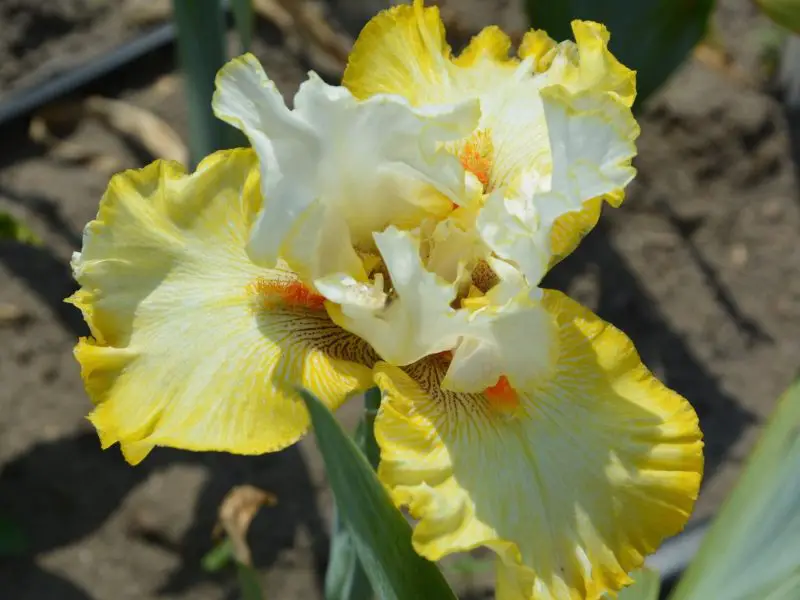
Iris germanica ‘Better Than Butter’ is a fragrant variety featuring creamy butter-colored blooms with ruffled petal edges. The standards are soft buttercream with a golden rim, while the falls have a pale lemon hue with yellow beards. A dewy sheen on the petals enhances their delicate texture.
This variety is valued for its sequential blooming habit, producing 8-9 buds per stem over a four-week period. Its wide, strappy, dark green foliage reaches up to 4 feet in height, adding an elegant, vertical element to the garden.
Plant Iris germanica ‘Better Than Butter’ in full sun, though some afternoon shade may be beneficial in warmer climates. It performs well in zones 3-9 and requires well-draining soil to thrive. Regular division ensures consistent flowering year after year.
Iris ensata ‘Lion King’
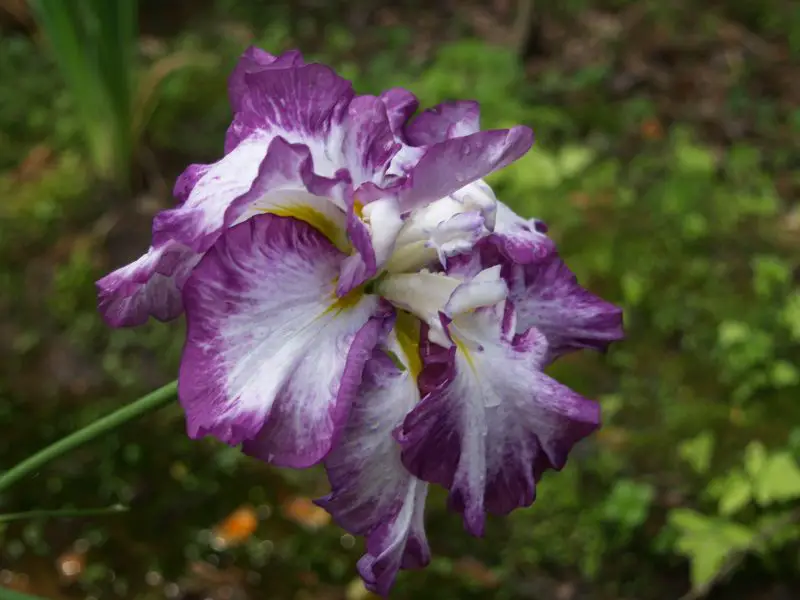
This striking Japanese iris (Iris ensata ‘Lion King’) features large, almost flat blooms with ruffled, slightly recurved petals. The white petal bases blend into rich grape-colored edges, creating a striking contrast. At the center, bright yellow signals add an extra layer of visual interest. Each bloom can reach up to 8 inches in diameter, making ‘Lion King’ a standout in the garden.
Foliage is thin, strappy, and remains attractive throughout the growing season. This variety thrives in moist soil, making it an excellent choice for water gardens, pondsides, or rain gardens. It is known for its vigorous growth and will spread steadily in ideal conditions.
Plant Iris ensata ‘Lion King’ in full to partial sun and provide consistent moisture for optimal blooms. Division every few years will help maintain its health and encourage more abundant flowering. It is well suited for USDA hardiness zones 4-9.
Iris ensata ‘Pink Frost’
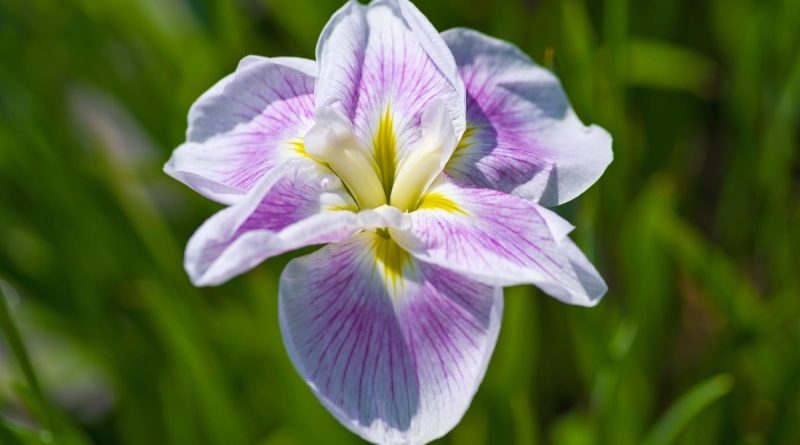
Iris ensata ‘Pink Frost’ is a delicate yet eye-catching Japanese iris with pale lavender petals and slightly darker veining. The flowers are large and flat, with bright yellow signals that draw pollinators to the garden. Each bloom exhibits a soft, elegant color contrast, adding a calming presence to the landscape.
The foliage is narrow, sword-like, and remains upright, resembling ornamental grass even after the flowering period. This variety thrives in wet soil during the growing season but requires drier conditions during dormancy. It is a great addition to gardens with well-managed water features.
Best grown in full to partial sun, Iris ensata ‘Pink Frost’ prefers consistently moist, slightly acidic soil. Avoid letting the rhizomes dry out completely, as this can hinder blooming. Hardy in zones 4-9, this iris is a graceful choice for perennial borders or wetland gardens.
Iris ensata ‘Variegata’
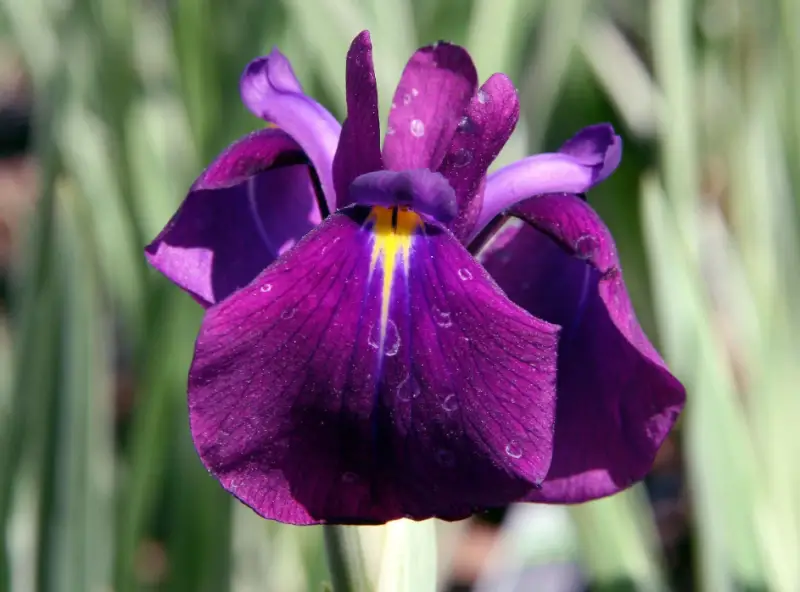
Iris ensata ‘Variegata,’ also called Silverband Iris, is prized for its striking variegated foliage with cream and dark green stripes. This iris is a favorite in Japanese-style gardens and midcentury landscapes due to its ornamental leaves that add beauty even when the plant is not in bloom.
Deep purple flowers emerge in summer, featuring bright yellow signals at their centers. The standards are small and delicate, while the falls are large and smooth, creating an elegant, balanced look. This variety forms dense clumps over time, making it a great option for naturalized settings.
Plant Iris ensata ‘Variegata’ in full to partial sun with consistently moist soil. It spreads readily in favorable conditions, so occasional division may be necessary to keep the clumps manageable. Hardy in zones 4-9, it performs best in damp environments, such as near ponds or streams.
Iris germanica ‘Beverly Sills’
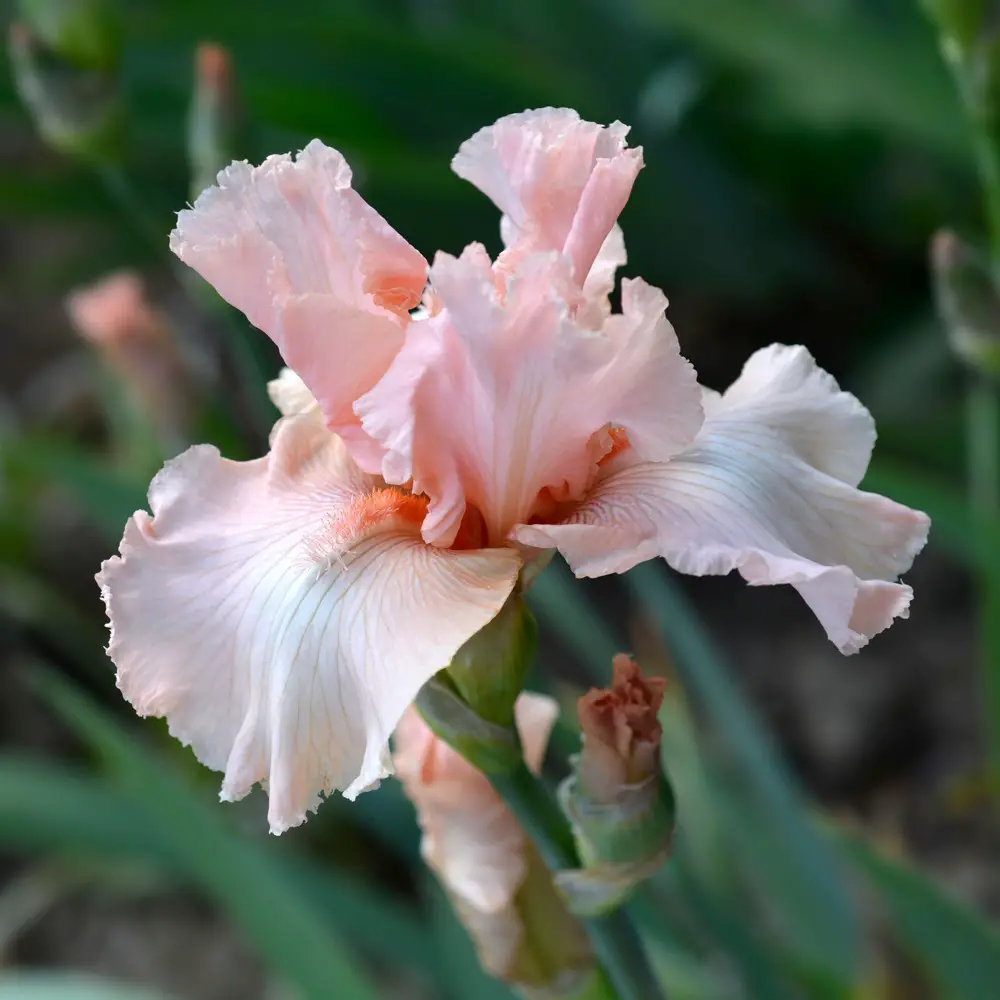
A standout in the Tall Bearded category, this cultivar offers salmon pink petals with peachy beards and centers. The veining is subtle, making the blooms appear as a solid wash of pink from a distance. The petals have a soft, ruffled texture, adding an elegant, airy feel. ‘Beverly Sills’ is known for its exceptional floriferousness, producing numerous flowers per stem, which makes it a favorite in both garden beds and floral arrangements.
The foliage is slender yet sturdy, featuring a deep green, waxy texture that remains attractive even when the plant is not in bloom. This variety thrives in loamy, slightly acidic soil with excellent drainage. Regular division every 2-3 years is recommended to prevent overcrowding and encourage prolific blooming.
For optimal growth, plant Iris germanica ‘Beverly Sills’ in full sun, as it needs at least six hours of direct light daily. It flourishes in USDA zones 3-9, reaching a height of 2-3 feet. Water sparingly, as irises dislike overly moist conditions, which can lead to root rot.
Iris germanica ‘Champagne Elegance’
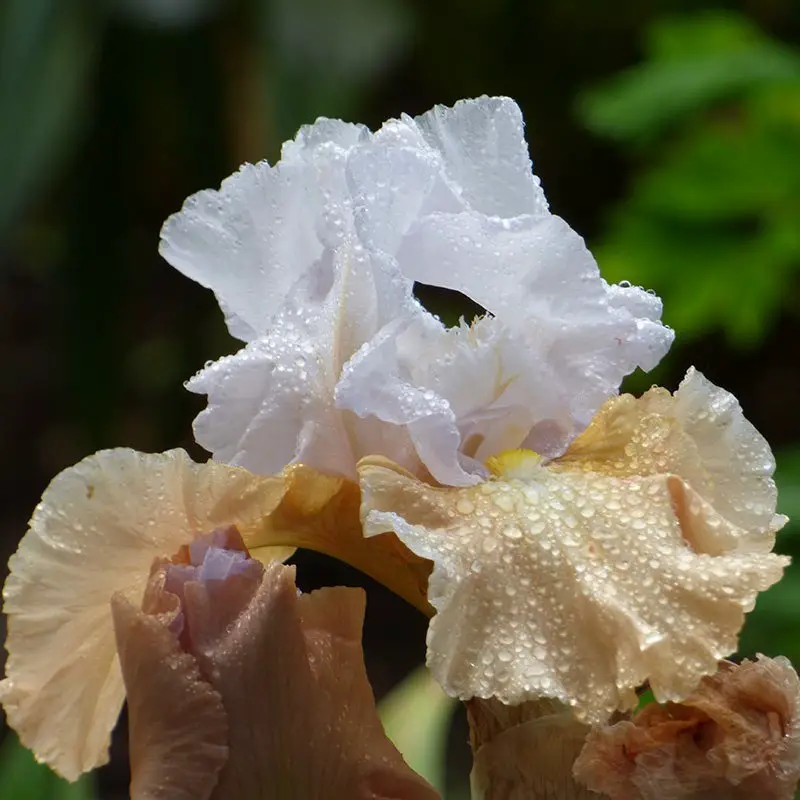
This reblooming German iris offers two blooming periods per year, with flowers opening in late spring and making a second appearance in late summer or early fall. Each strong, upright stem bears 7-10 buds, which open in succession to reveal large, billowy blooms with creamy white standards and champagne to apricot-hued falls. The color contrast adds a sophisticated touch to any garden setting.
At the base of each petal, a golden-yellow flush complements the bright, fuzzy beards, enhancing the flower’s warm tones. The edges of the petals are gently ruffled, adding to its graceful appearance. ‘Champagne Elegance’ also emits a soft, orange blossom fragrance, making it a delightful choice for walkways and seating areas where its scent can be fully enjoyed.
Growing to a height of 2-3 feet, this variety thrives in USDA zones 3-9 with full sun exposure. It requires well-drained soil to prevent rhizome rot and should be divided every few years to maintain its vigorous blooming habit. Deep watering during dry spells will keep it healthy, but excess moisture should be avoided.
Iris germanica ‘Dangerous Liaison’

The striking color contrast of ‘Dangerous Liaison’ makes it one of the most dramatic Tall Bearded iris varieties. Its large, upright standards are a soft lavender hue with stiff ruffling that adds texture and depth. The falls are a deep, velvety plum shade with a delicate purple edging and subtle veining near the center, creating an almost regal effect.
Amber-colored beards provide additional contrast, standing out boldly against the darker petals. The sword-like foliage has a slightly bluish tint and a matte finish, rising to support the blooms at a height of 2-3 feet. This variety makes a stunning focal point in perennial borders or mixed beds.
‘Dangerous Liaison’ performs best in USDA zones 3-9 with full sun exposure. It prefers well-drained soil and benefits from periodic division every 3-4 years to ensure continuous flowering. Watering should be minimal to avoid rhizome rot, and deadheading spent blooms will encourage a tidy appearance throughout the season.
Iris germanica ‘Grand Canyon Sunset’
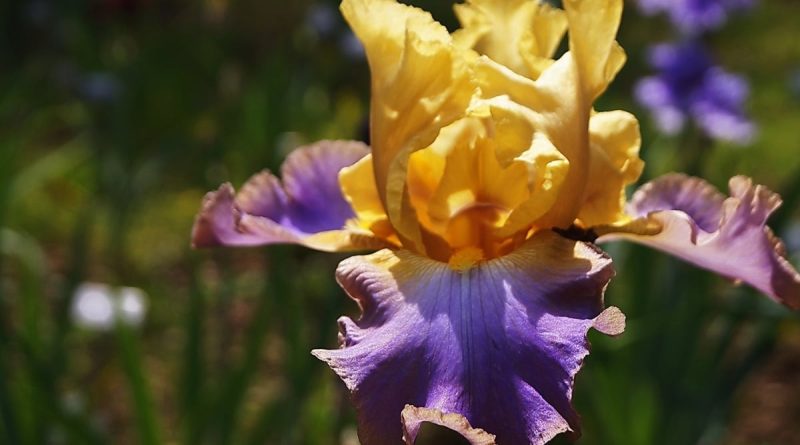
A visual representation of a desert sunset, ‘Grand Canyon Sunset’ boasts a mesmerizing blend of plum, copper, tangerine, pink, and gold. Its rich, warm hues bring a dramatic touch to any garden, while the thick, firm petals ensure long-lasting beauty. Both the standards and falls are of similar size, creating a well-balanced, symmetrical bloom. The thick, orange beards add a bold pop of color at the flower’s center.
Each stem reaches up to 3 feet in height and features two branching structures, allowing for an abundant floral display with about 10 buds per season. This profuse blooming habit makes ‘Grand Canyon Sunset’ a top choice for garden enthusiasts looking for continuous color.
Best suited for USDA zones 3-9, this iris requires full sun and well-draining soil to thrive. Mulching around the base can help retain moisture without over-saturating the roots. Regular division every few years prevents overcrowding and keeps plants vigorous.
Iris germanica ‘Pink Attraction’
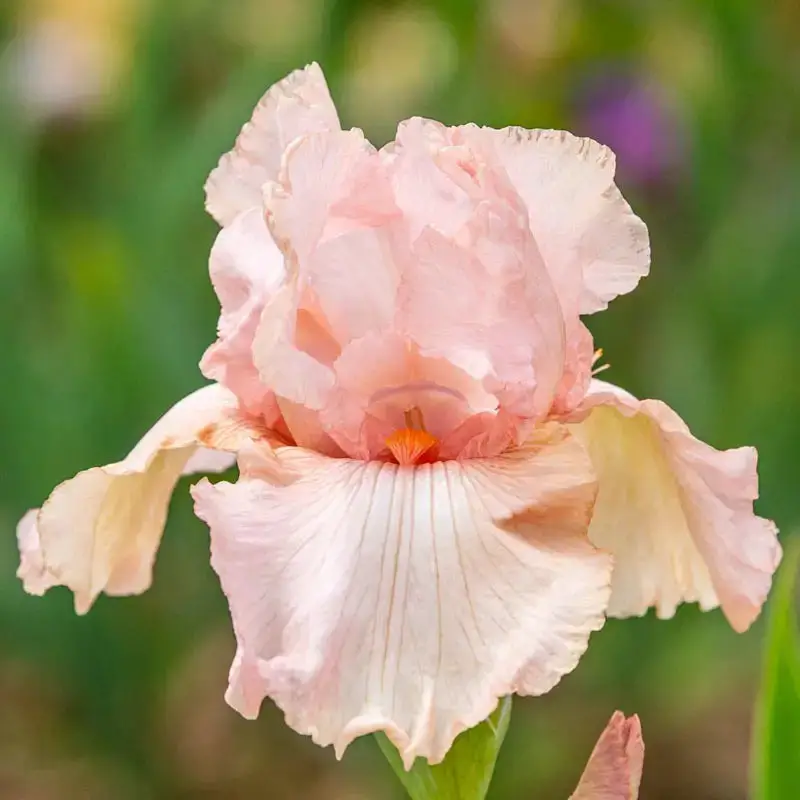
A charming reblooming variety, ‘Pink Attraction’ showcases blush-colored flowers with faint veining and gently sheared petal edges. The soft, ruddy pink tones deepen near the base of the falls, giving the blooms a warm, glowing appearance. The beards range in color from peach to deep pink, adding a delicate highlight to the overall look.
As a Tall Bearded iris, ‘Pink Attraction’ provides two distinct blooming periods, first in late spring and again in late summer to early fall. Its reblooming capability makes it a favorite for gardeners looking for extended color throughout the growing season. Each flower stands proudly on sturdy stems, supported by a fan of sword-like green foliage.
Growing best in USDA zones 3-9, ‘Pink Attraction’ thrives in full sun and well-draining soil. To maintain its reblooming nature, provide occasional fertilization and divide clumps every few years. Avoid excessive watering, as this can lead to rhizome rot, and ensure adequate spacing between plants to promote air circulation and prevent disease.
Iris germanica ‘Sugar Blues’
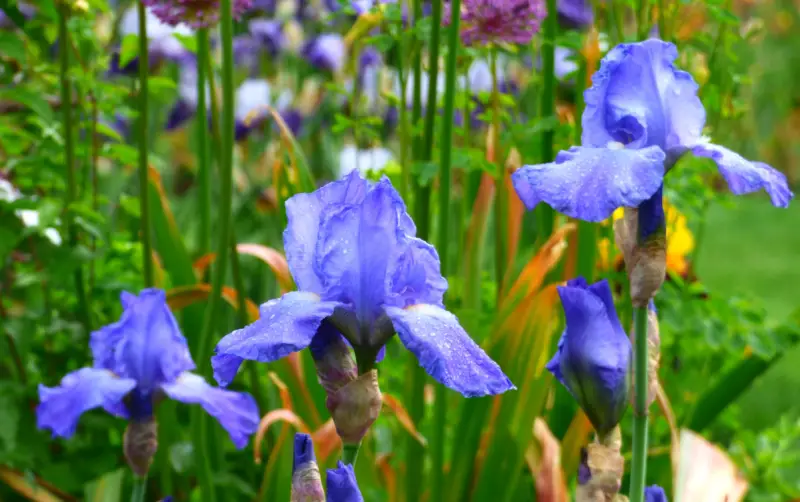
‘Iris germanica ‘Sugar Blues’ is a striking cultivar that blooms twice a season, making it an excellent choice for gardeners who want prolonged color. This iris variety features delicate double flowers with petals that range in color from soft cornflower blue to violet. The standards, or upper petals, tend to be slightly lighter than the falls, or lower petals, creating a pleasing contrast. The centers of the blooms are white, with intricate blue veins running through them, and the flowers are accented with white beards tipped with yellow, adding a pop of warmth to the cool tones of the petals.
‘Sugar Blues’ is especially well-suited to cooler climates, thriving in USDA zones 3-9. This variety is known for being very cold-hardy and will reliably rebloom each year, even in chillier regions. However, in hotter climates, particularly with intense afternoon sun, it may struggle and the blooms may wilt. To get the most out of this plant, it’s best to plant it in a location that receives full sun. The plant grows to a height of 2-3 feet and looks stunning when paired with other flowering plants, such as roses, pink dahlias, or other cottage garden favorites.
For best growth, ‘Sugar Blues’ requires well-draining soil, as it does not tolerate excess moisture, which can cause the rhizomes to rot. Divide the plant every 2-3 years to prevent overcrowding and encourage more prolific blooms. Water the plant sparingly, making sure the soil is dry between waterings. This iris is perfect for creating eye-catching borders or as part of a mixed perennial bed.
Iris germanica ‘Titan’s Glory’

A true show-stopper in the garden, ‘Titan’s Glory’ features large, rich royal purple flowers that will instantly catch the eye. The flowers are impressive, with standards that are tightly clustered and upright, forming a striking contrast against the looser, more open falls. The deep purple color of both the standards and falls creates an almost regal effect, especially when complemented by dark purple beards that add an extra layer of contrast to the flower. The beards are the same shade as the petals, enhancing the overall visual appeal.
This German cultivar is especially known for its strong fragrance, which adds another layer of charm. The fragrance is rich and noticeable, making ‘Titan’s Glory’ a fantastic addition to cutting gardens or any area where its scent can be fully appreciated. Each stem can produce up to 8 blooms, making this iris a true standout in any arrangement. The plant itself grows to a height of 2-3 feet and features thick, sword-like foliage that remains attractive throughout the growing season.
‘Iris germanica ‘Titan’s Glory’ grows best in full sun, as it requires a minimum of six hours of direct sunlight daily to thrive. It is hardy in USDA zones 3-9 and prefers well-draining soil. To keep it healthy and encourage vibrant blooms, it should be watered sparingly and allowed to dry between waterings to avoid root rot. Regular division every 3-4 years helps prevent overcrowding and ensures the plant continues to produce abundant flowers.
Iris germanica ‘Silverado’
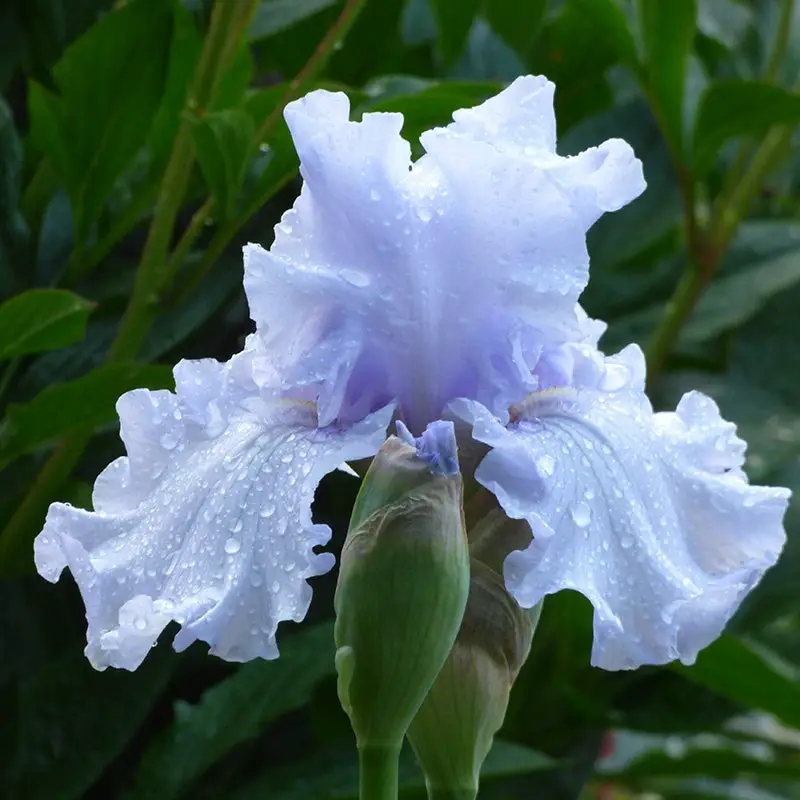
‘Iris germanica ‘Silverado’ is a striking cultivar known for its pale lavender blooms that boast a silver-to-blueish-white appearance, especially from a distance. The flowers have formal ruffled petals with a stiff texture, giving them a structured and elegant look. The centers of the flowers are light and delicate, with a white beard tipped with yellow that adds a touch of warmth to the otherwise cool-toned blooms. The color of the flowers deepens slightly as you move down the petals, enhancing the contrast and beauty of the flower.
This variety grows tall, reaching up to 4 feet, making it one of the taller bearded irises. Each stem can produce up to eight buds, creating an abundant floral display that is sure to impress. The foliage is a rich, natural green with striped texture that contrasts beautifully with the pale flowers. ‘Silverado’ thrives in full sun and prefers well-drained soil to ensure that its rhizomes do not become waterlogged. Like other irises, it benefits from division every few years to encourage healthy growth and prevent overcrowding.
‘Silverado’ is hardy in USDA zones 3-9, making it suitable for a wide range of climates. This iris is perfect for use in borders, perennial beds, or as a standout in the cutting garden. It does best with deep watering during dry spells, but it is important to avoid excessive moisture, which can lead to rhizome rot. By following these guidelines, you’ll be able to enjoy the long-lasting beauty of ‘Silverado’ for many years to come.
Iris sibirica ‘Pink Parfait’
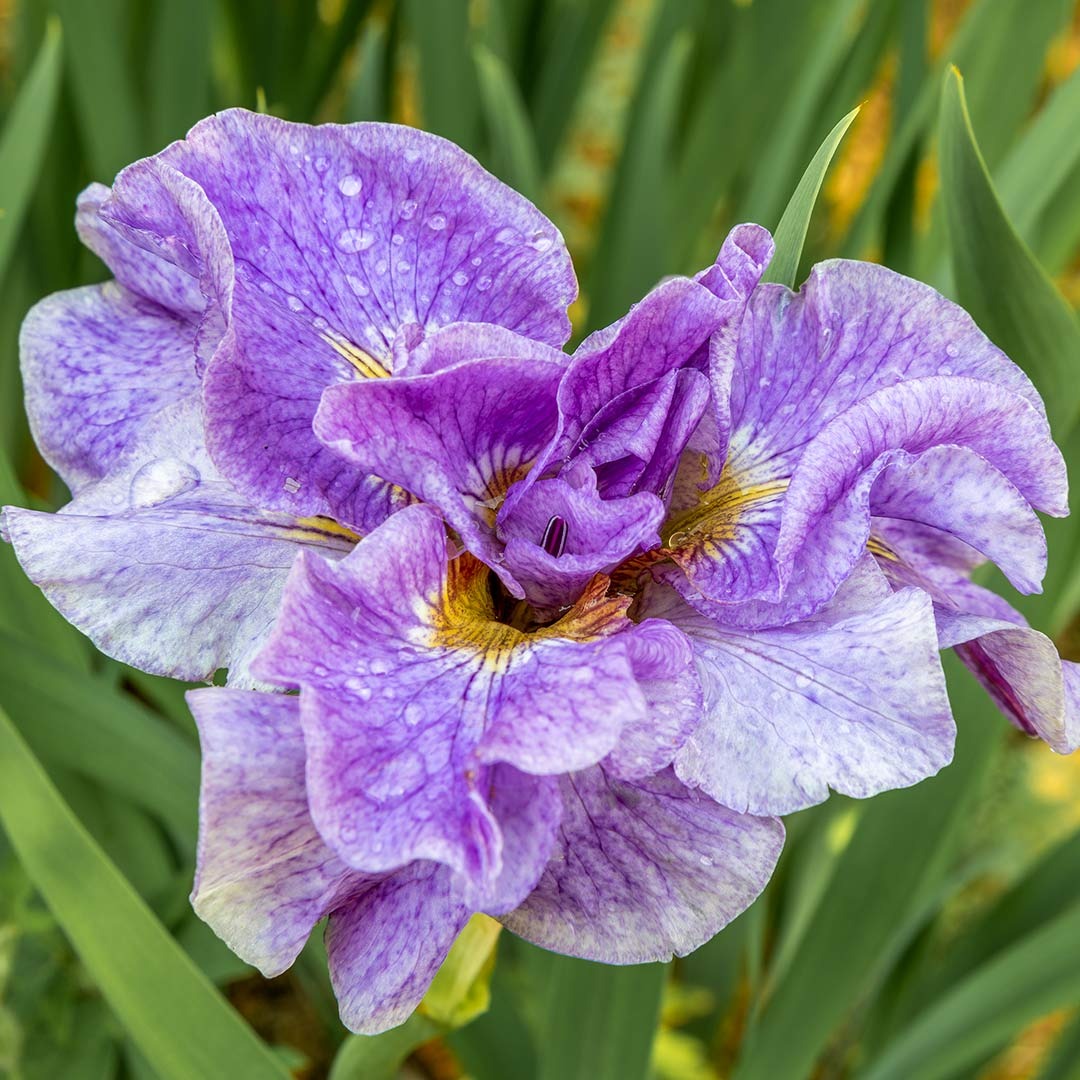
‘Pink Parfait’ is a unique variety of Siberian iris, distinguished by its double-layered flowers in a soft lavender color. The petals have a mottled veining pattern that adds visual interest, while the edges are solid, creating a well-defined and appealing appearance. The centers of the flowers are bright yellow with white outlines, creating a striking contrast against the soft lavender petals. The flowers have a delicate texture with only a slight ruffling, and they appear as an elegant, full bloom.
The foliage of ‘Pink Parfait’ is slender and less rigid than that of German irises, creating a soft and fan-like appearance. The upright foliage provides a beautiful contrast to the delicate flowers, giving the plant structure even when it is not in bloom. This Siberian iris variety thrives in USDA zones 3-9 and does best when planted in full sun, though it will tolerate some light shade. It requires well-draining soil and should be watered sparingly, as it does not like to sit in water.
To keep ‘Pink Parfait’ growing strong, it’s important to divide the plant every few years. This helps to prevent overcrowding and encourages continued flowering. The plant’s sturdy nature and beautiful blooms make it a wonderful choice for the garden, where it will provide color and structure throughout the growing season.
Iris sibirica ‘Sunfisher’
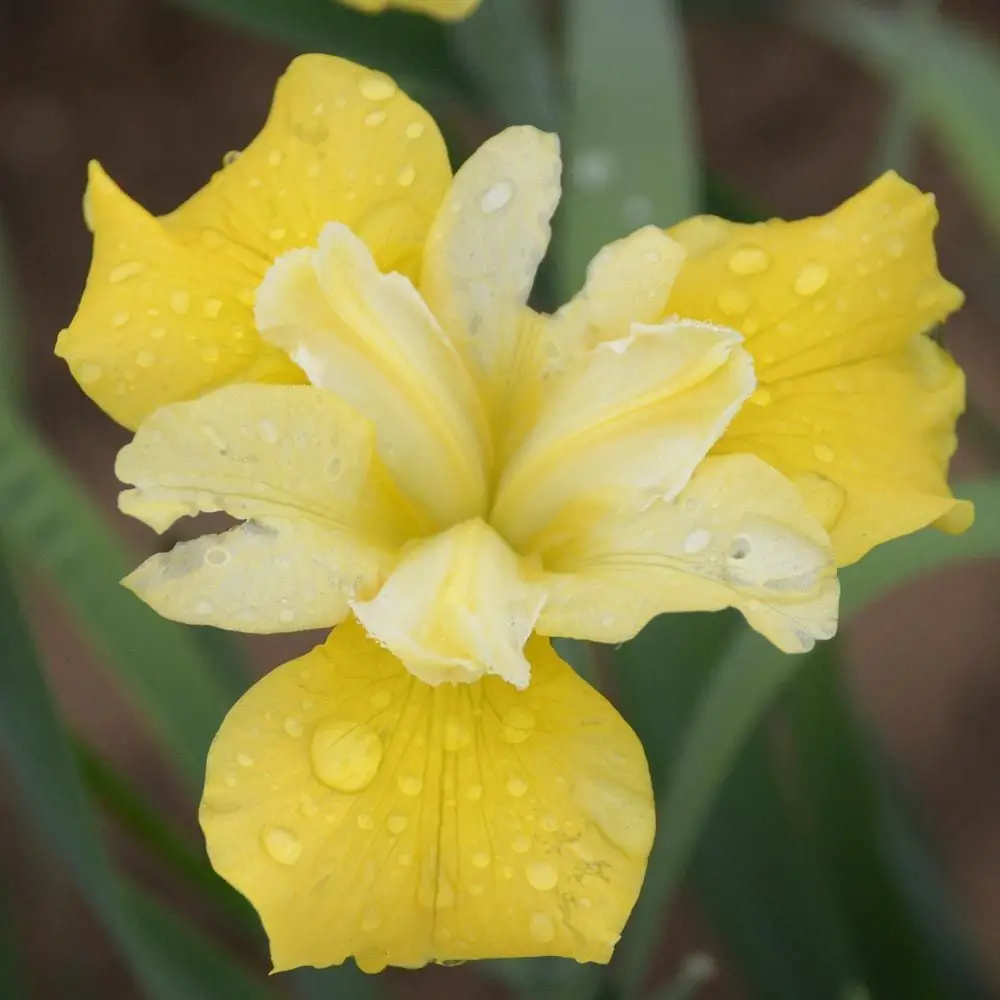
A cheerful addition to any garden, ‘Sunfisher’ produces bright lemon-yellow flowers that truly stand out in the landscape. The falls are a vibrant yellow with subtle veining, while the standards are a pale yellow with strong-colored midribs. The petals are ruffled, giving the flowers a soft, billowing appearance that resembles a bouquet of sunshine. This Siberian iris is especially known for its lively personality, which can brighten any garden or bed.
‘Sunfisher’ is perfect for early-season blooms, adding a cheerful splash of color when many other plants have yet to flower. It thrives in full sun, which helps the bright yellow petals achieve their most vivid color. While it will tolerate some light shade, it may produce fewer flowers in those conditions. The plant grows to a height of 2-3 feet and features sword-like foliage that rises from the base, supporting the blooms above.
This variety is hardy in USDA zones 3-9 and is well-suited for a wide range of climates. Like most Siberian irises, ‘Sunfisher’ prefers well-drained soil and should be watered moderately to avoid waterlogged roots. Regular division every few years will help prevent overcrowding and encourage continuous blooming throughout the season. With its bright, sunny flowers and cheerful personality, ‘Sunfisher’ is a fantastic addition to any garden.
Iris hollandica ‘Apollo’
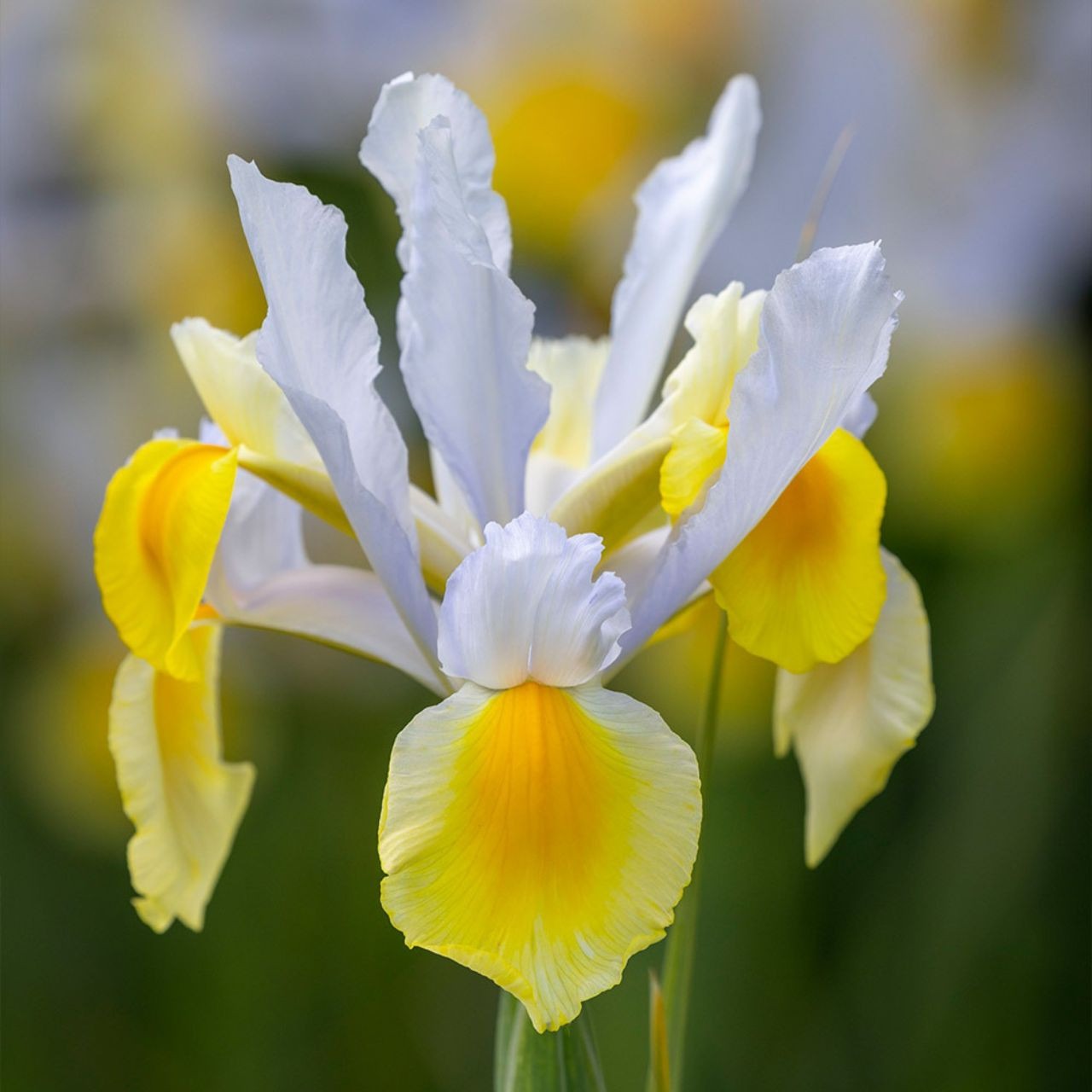
Iris hollandica ‘Apollo’ is a charming Dutch iris cultivar with a striking appearance, showcasing narrow, white standards and bright yellow falls with orange markings in the center. The flowers are medium-sized, with the falls slightly drooping and curving downward, resembling delicate buttercups. The contrast between the white standards and the golden-yellow falls creates a visually appealing effect that stands out in the garden.
Growing to a height of 1-2 feet, ‘Apollo’ thrives in full sun and well-draining soil, making it ideal for USDA hardiness zones 6-9. Its tubular sage-green foliage complements the vibrant blooms, offering a balanced aesthetic. This iris is perfect for creating colorful carpets when planted with low-spreading perennials like phlox or catmint. Its pleasant fragrance and long-lasting blooms also make it an excellent choice for cut flower arrangements, adding both color and scent to any indoor space.
To ensure healthy growth, plant ‘Apollo’ in a sunny spot with good drainage, as excessive moisture can lead to root rot. While it does not require frequent watering, it benefits from occasional irrigation during dry periods. Additionally, dividing the bulbs every 2-3 years helps prevent overcrowding and promotes vigorous flowering.
Iris hollandica ‘Blue Magic’
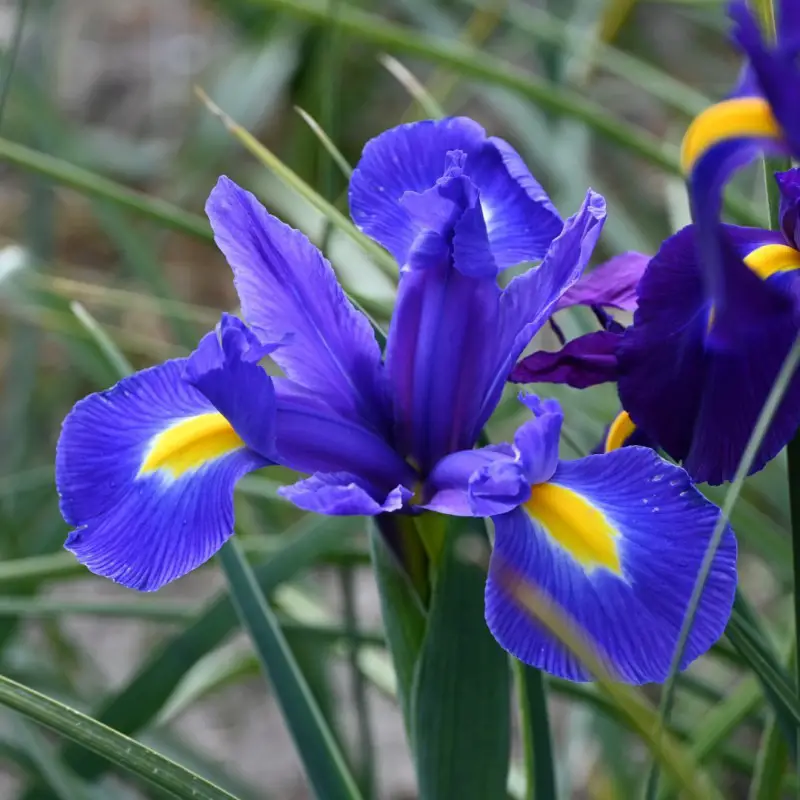
Iris hollandica ‘Blue Magic’ is a stunning cultivar known for its deep purple flowers with striking yellow markings. The flowers feature long, flat standards with ruffled tips in shades of periwinkle, while the falls are heart-shaped and dark violet with a vivid yellow flash near the center. The overall effect is bold and captivating, perfect for adding drama to your garden.
This variety grows to a height of 1-2 feet and is well-suited to full sun conditions, making it a reliable bloomer in USDA hardiness zones 6-9. ‘Blue Magic’ typically blooms from late spring to early summer, providing 2-3 weeks of vibrant color. Its reed-like foliage remains attractive even after flowering, adding a structural element to the garden. For best results, ensure good drainage, as ‘Blue Magic’ does not tolerate wet soil.
Like other bulb irises, ‘Blue Magic’ should be planted in well-draining soil to avoid rot. It is an excellent choice for borders, containers, or mixed beds, but it may not perennialize in areas with harsh winter temperatures. Regular division every few years helps maintain healthy growth and encourages fresh blooms.
Iris hollandica ‘Red Ember’
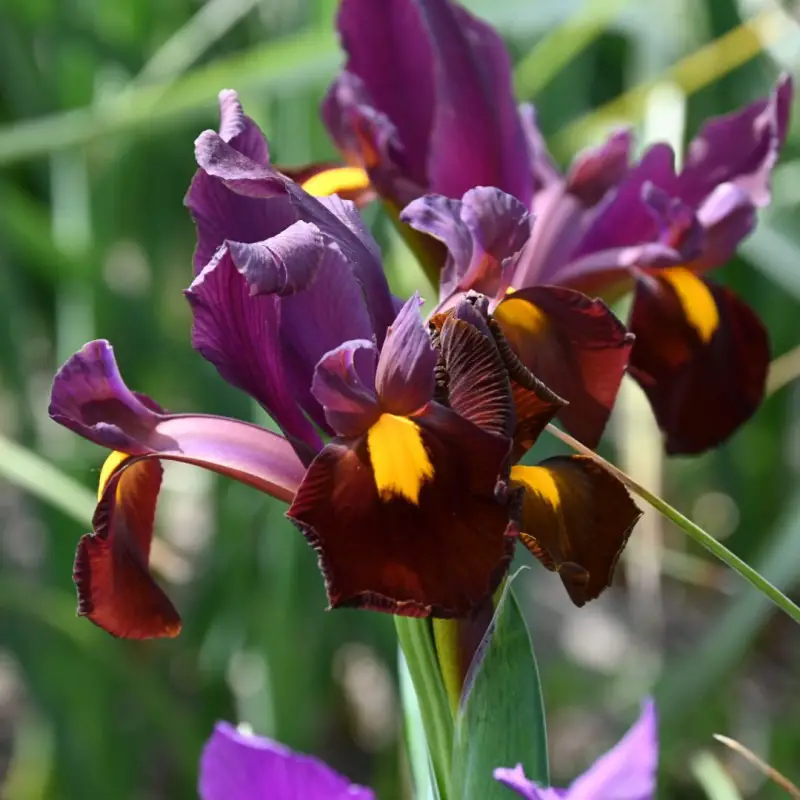
Iris hollandica ‘Red Ember’ is a striking Dutch iris variety with unique reddish-brown falls and yellow spots near the base, offering a bold splash of color in the garden. The standards are narrow and upright, initially appearing grape-hued but fading to a bluish-red as they mature. The falls develop a rich reddish-brown color, turning bronze as the blooms near the end of their flowering period. These stunning flowers make a dramatic statement in any garden or floral arrangement.
Reaching a height of 1-2 feet, ‘Red Ember’ thrives in full sun and well-draining, loamy soil, making it suitable for USDA hardiness zones 6-9. Its dense, fan-shaped leaf structure adds to its appeal, especially when planted along borders or in groupings. This iris is perfect for creating visual interest in your garden with its rich colors and elegant form.
To ensure healthy blooms, plant ‘Red Ember’ in an area with good sunlight, particularly during the first half of the day, to allow the flowers to reach their full potential. Avoid excessive moisture to prevent root rot, and divide the bulbs every 2-3 years to maintain healthy growth.
Iris histrioides ‘Katharine Hodgkin’

Iris histrioides ‘Katharine Hodgkin’ is a delightful dwarf variety of iris, perfect for smaller gardens or as a ground cover. The flowers bloom in early spring and feature delicate white petals with striking blue veining, bright yellow centers, and black signal spots. The flat, unruffled petals create an elegant profile, and the plant’s compact size makes it ideal for planting in rock gardens, along borders, or near the edges of garden beds.
Growing to a height of only 4-6 inches, ‘Katharine Hodgkin’ thrives in full sun to part shade, making it adaptable to different garden conditions. It is hardy in USDA zones 5-8 and spreads easily by bulblets, quickly establishing itself in the landscape. This iris is an excellent choice for naturalizing, as it will form attractive clusters that gradually fill in over time.
As a bulb iris, ‘Katharine Hodgkin’ benefits from well-draining soil to prevent waterlogged roots. It will flourish in partial shade, making it perfect for planting under trees or in areas with dappled sunlight. Divide the bulbs every 2-3 years to ensure healthy growth and continued blooming.
Iris reticulata ‘Scent Sational’
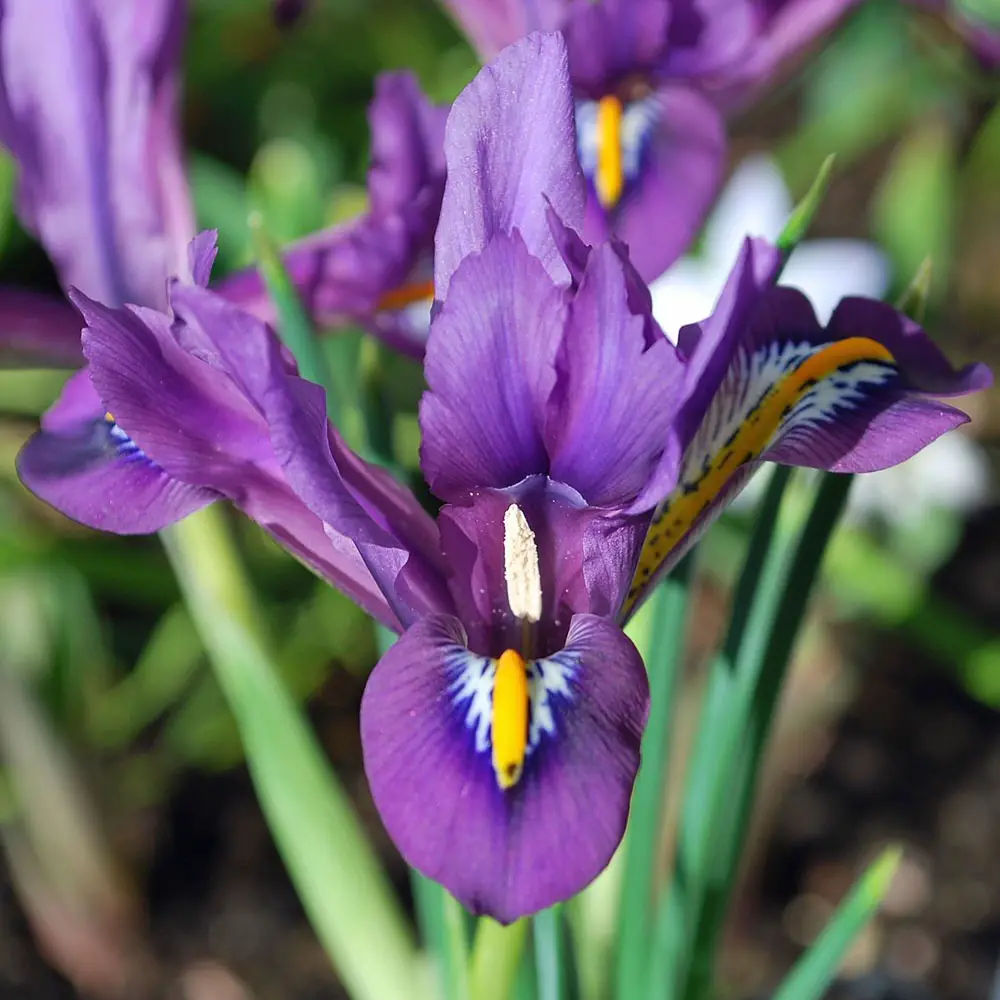
Iris reticulata ‘Scent Sational’ is a captivating dwarf iris variety known for its bright purple flowers with striking white centers, purple freckles, and a sunny yellow midrib band on the falls. The standards are royal purple with a slight ruffle, and the falls are spade-shaped and down-drooping. The fragrance of the blooms, as the name suggests, is delightful, adding a sensory element to your garden.
Standing at just 4-6 inches tall, ‘Scent Sational’ is one of the first irises to bloom in late winter or early spring, making it a welcome sight after the cold months. It thrives in full sun to part shade and is hardy in USDA zones 5-8. Plant it in drifts or group it together in containers to create a striking display of color early in the season.
Like other bulb irises, ‘Scent Sational’ requires well-draining soil and should be watered sparingly to avoid rot. It’s a great option for rock gardens, borders, or even as a potted plant near the patio. The plant will naturalize over time, adding charm and color to your garden year after year.
Iris reticulata ‘Clairette’
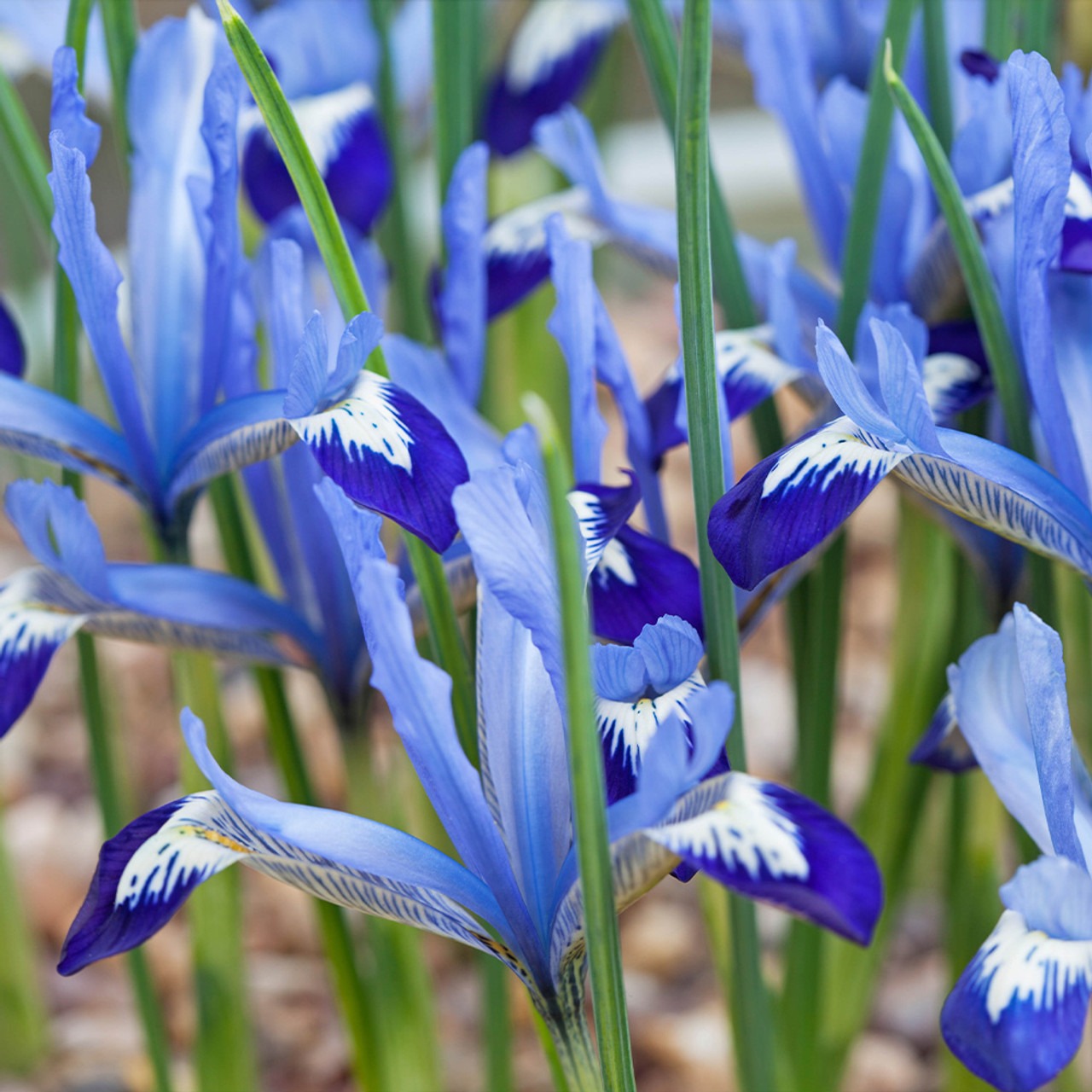
Iris reticulata ‘Clairette’ is a delightful dwarf iris variety that blooms early in spring, often mistaken for a crocus due to its short stature and vibrant flowers. Standing at just 4-5 inches tall, it features fringy, upright standards in a beautiful shade of china blue. The falls are tongue-shaped, with royal blue tips, framed by white centers adorned with blue freckles. A sunny yellow stripe runs along the midrib of the falls, enhancing the flower’s delicate appearance.
This iris thrives in full sun to part shade and is hardy in USDA zones 5-8. ‘Clairette’ is an excellent choice for rock gardens, containers, or naturalizing in borders. The foliage, which is chartreuse green and chive-like in texture, continues to grow after flowering and reaches up to 15 inches before eventually dying back naturally. As a bulb iris, it is easy to care for and requires little maintenance once established, blooming reliably every spring.
To ensure healthy growth, plant ‘Clairette’ in well-drained soil and avoid overwatering, as excess moisture can lead to rot. The plant’s compact size makes it perfect for small spaces, and it can be used to create a charming early spring display.
Iris reticulata ‘Eye Catcher’
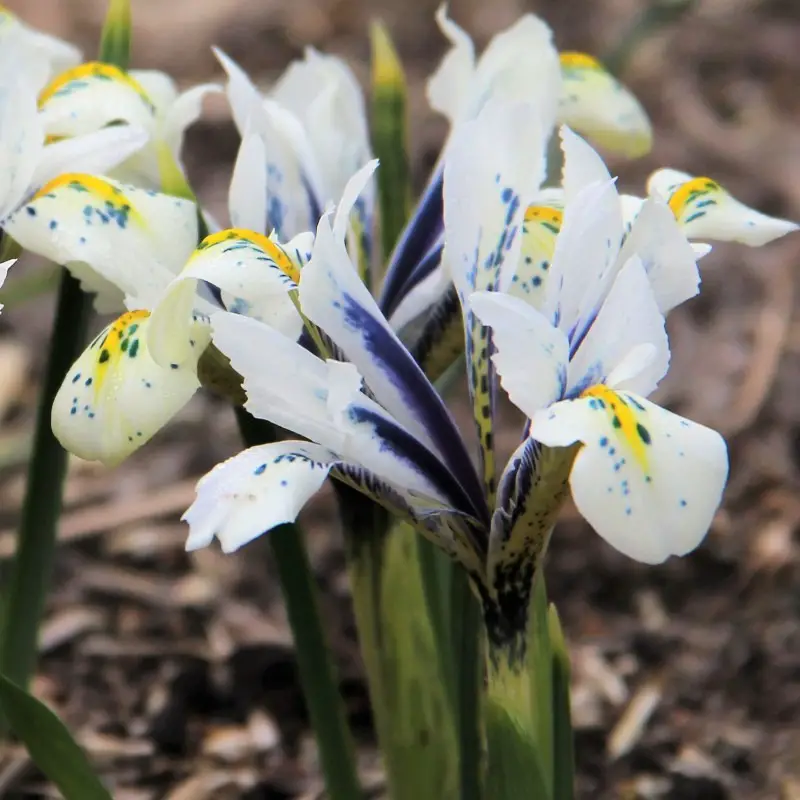
Iris reticulata ‘Eye Catcher’ is a stunning dwarf iris variety with large, showy flowers that captivate in early spring. Standing at just 2-4 inches tall, this iris features narrow, upright standards in white, with indigo midribs fanning out into white edges. The falls are creamy white with yellow spots and blue freckles, creating a striking contrast. The combination of indigo, white, and yellow makes ‘Eye Catcher’ a standout in the garden.
This iris thrives in full sun to part shade and is hardy in USDA zones 5-8. Its low-growing habit makes it ideal for planting among other spring bulbs, such as grape hyacinths or daffodils, to create a beautiful early-season display. ‘Eye Catcher’ is easy to grow and requires minimal maintenance, making it a great addition to any garden or container.
Plant ‘Eye Catcher’ in well-drained soil and ensure it receives enough sunlight for healthy blooms. Its small stature makes it perfect for rock gardens or borders, and it will naturalize over time, adding charm and color to your garden year after year.
Iris louisiana ‘Black Gamecock’
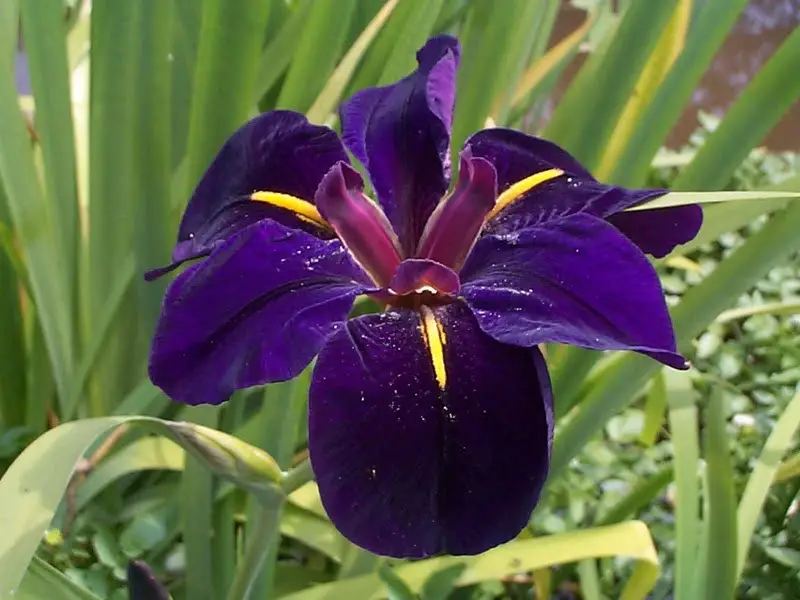
Iris louisiana ‘Black Gamecock’ is a striking Louisiana iris that blooms in early to mid-summer, producing velvety purple flowers with bright yellow stripes on the midribs of the falls. The standards are small, with wine-colored midribs and burgundy perimeters, while the falls are spade-shaped with a slight ruffle. The deep purple coloring of the falls appears almost black in low light, creating a dramatic effect in the garden.
Reaching a height of 2-3 feet, ‘Black Gamecock’ thrives in full sun to part shade and is hardy in USDA zones 6-10. It performs well in boggy conditions, making it perfect for waterside settings or areas with moist soil. The lime-green, sword-like foliage provides a lovely contrast to the dark blooms and adds structure to the garden.
As a Louisiana iris, ‘Black Gamecock’ will multiply easily, forming clumps that create a bold display. It is ideal for naturalizing in wetland areas or as part of a rain garden. To keep it thriving, plant it in well-drained, moisture-retentive soil and divide the rhizomes every few years to prevent overcrowding.
Iris louisiana ‘Ann Chowning’
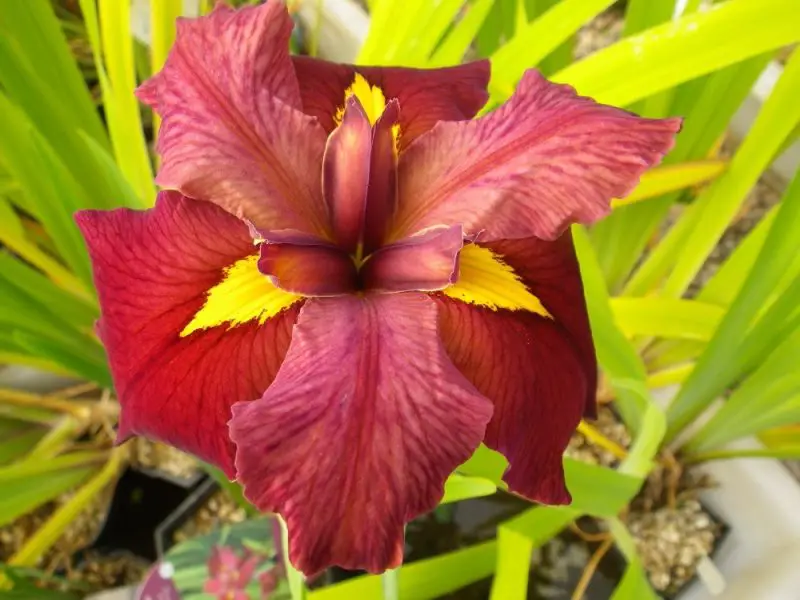
Iris louisiana ‘Ann Chowning’ is a vibrant Louisiana iris that produces bold, 6-inch crimson-red blooms with subtle veining and bright yellow signals. The flowers are complemented by orange signals and beards, making them particularly attractive to pollinators like bees and butterflies. This cultivar stands out in waterside gardens, adding a splash of color with its rich red hues.
Growing to a height of 2-3 feet, ‘Ann Chowning’ thrives in full sun to part shade and is hardy in USDA zones 6-10. It is perfect for planting near ponds, streams, or wetland areas, where it can handle moist conditions. The lime-green, stiff foliage adds structure to the garden and provides a beautiful contrast to the fiery red flowers.
To keep ‘Ann Chowning’ healthy, plant it in moist, well-draining soil and provide at least 5 hours of sun per day. It will tolerate some shade, but for optimal growth and flowering, it should receive plenty of sunlight. Divide the rhizomes every 2-3 years to maintain healthy growth and encourage fresh blooms.
Iris louisiana ‘Acadian Miss’
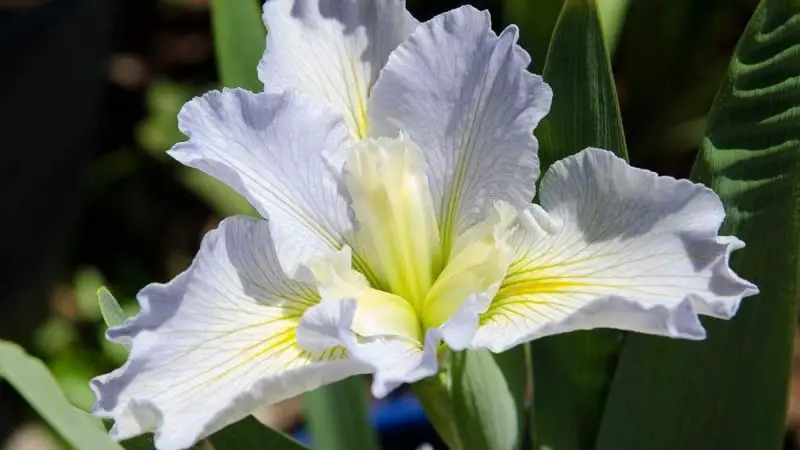
Iris louisiana ‘Acadian Miss’ is an elegant Louisiana iris that produces large, ruffled white flowers with lemon-colored midribs and centers. The petals have a crepe-paper texture, and the plant’s striking white blooms are complemented by the lime-green, sword-like foliage. This cultivar reaches a height of 2-3 feet and is perfect for waterside gardens or wetland areas, where it thrives in moist conditions.
‘Acadian Miss’ is hardy in USDA zones 6-10 and grows best in full sun to part shade. The flowers are 6 inches wide and bloom in late spring to early summer, attracting bees and butterflies. The plant’s foliage continues to grow after flowering and stays green in warmer climates, providing year-round interest.
As a Louisiana iris, ‘Acadian Miss’ will spread aggressively, so it is best to plant it in areas where it has room to grow. Divide the rhizomes every 2 years to prevent overcrowding and ensure healthy growth. This iris thrives in moist, well-drained soil, and its stunning white flowers make it a standout in any water garden or border.
Iris lactea ‘Milky Iris’
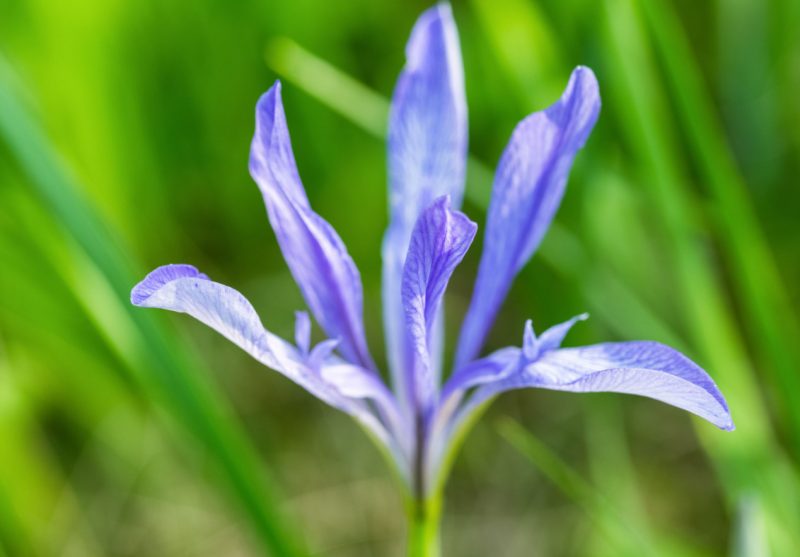
Iris lactea ‘Milky Iris’ is a charming iris species native to Central Asia. It features small, violet blooms with pale lavender veins and a rounded habit. The flowers are dainty, measuring just 2-3 inches long, and appear in clusters of 2-4 per stem. The plant’s arching, spiky foliage creates a delicate, graceful effect in the garden. Growing to a height of 6 inches to 2 feet, ‘Milky Iris’ is an excellent choice for adding soft color to a sunny border or rock garden.
This iris thrives in full sun and well-draining soil, and it is hardy in USDA zones 3-9. The blooms are delicate, with a soft, pastel appearance that contrasts beautifully with the darker green foliage. ‘Milky Iris’ is a spreading iris that forms clumps, so regular division is needed to encourage full blooming.
For the best results, plant ‘Milky Iris’ in a sunny location with good drainage. Its understated beauty and ability to naturalize make it an excellent addition to a variety of garden styles.
Iris ensata ‘Magic Opal’
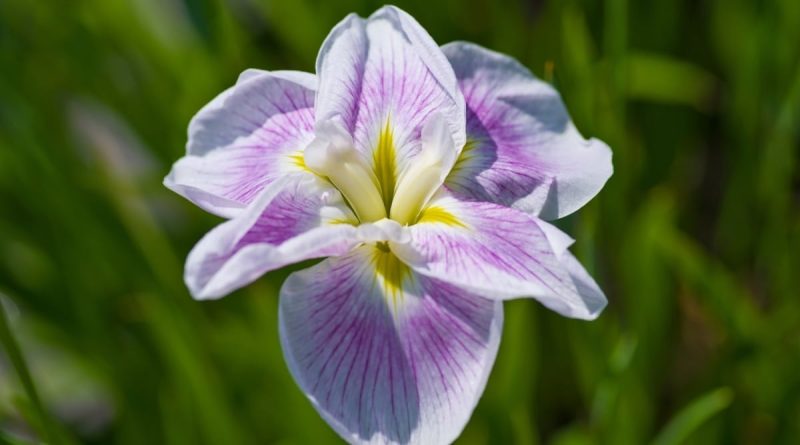
Iris ensata ‘Magic Opal’ is a graceful Japanese iris that blooms in midsummer. It features large, flat flowers with soft lavender falls adorned with lemon yellow bursts and dark purple veins. The standards are small and thin, with pale lavender midribs and darker perimeters. The 8-inch wide blooms have a drooping habit that adds elegance to the garden. Standing at 2-3 feet tall, ‘Magic Opal’ is an attractive, low-maintenance iris that works well in both formal and informal settings.
This cultivar thrives in full to part sun and is hardy in USDA zones 4-9. Its thin, pale green foliage provides vertical interest and texture before and after blooming. ‘Magic Opal’ is a beautiful iris that pairs well with other irises or aquatic plants in a water garden.
To grow ‘Magic Opal’ successfully, plant it in moist, well-drained soil where it will receive adequate sunlight. Its large, showy flowers and graceful form make it a standout addition to any garden.
Iris germanica ‘Chasing Rainbows’

Iris germanica ‘Chasing Rainbows’ is a Tall Bearded iris known for its exquisite, ruffled flowers in shades of peach, grape, and golden yellow. The large, grape-colored standards have peachy perimeters and vibrant midribs, while the falls are predominantly grape with a peach border. The beards are a bold, golden yellow, adding a lovely contrast to the floral hues. Standing at 2-3 feet, this iris brings a striking, colorful display to any garden.
This iris thrives in full sun to part shade and is hardy in USDA zones 3-9. Its vigorous blooming makes it an ideal choice for both urban and rural gardens, and its robust nature ensures that it will adapt to a variety of landscapes. The foliage is rigid and dark green, providing a solid backdrop to the colorful blooms. ‘Chasing Rainbows’ also has a light, clean fragrance, making it a delightful addition to your garden or home when cut for floral arrangements.
Plant it in well-draining soil, and with proper care, this iris will flourish year after year, bringing beauty and joy to your spring garden.
Iris germanica ‘Diamond Blush’
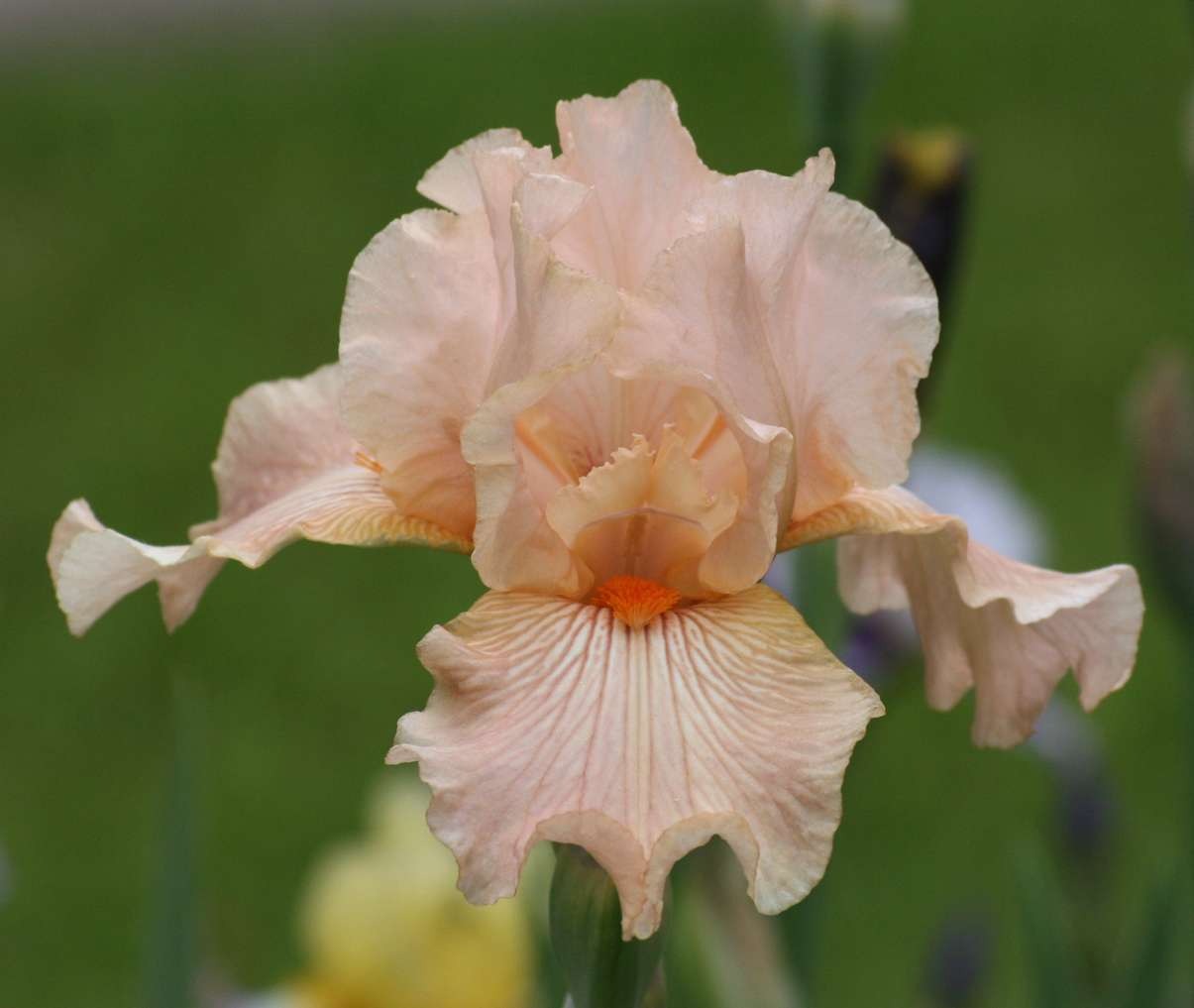
Iris germanica ‘Diamond Blush’ is a stunning Tall Bearded iris with fragrant, blush-pink flowers that have a romantic appeal. The blooms feature curly, apricot standards and slightly looser falls, which are tipped with a soft blush-pink hue. Tangerine-orange beards and veining add warmth and depth to the petals. Reaching heights of 2-3 feet, this iris is perfect for adding color and fragrance to your garden.
This cultivar is particularly admired for its ability to bloom twice a year—once in spring and again in fall—making it a versatile and long-lasting addition to any garden. It thrives in full sun and is hardy in USDA zones 3-9. The foliage is a sage-green color, adding an elegant contrast to the warm, peachy tones of the flowers.
To ensure optimal growth, plant ‘Diamond Blush’ in a sunny location with well-draining soil. With its twice-yearly blooms and lovely fragrance, this iris will be a standout in your garden.
Iris brevicaulis ‘Zigzag’
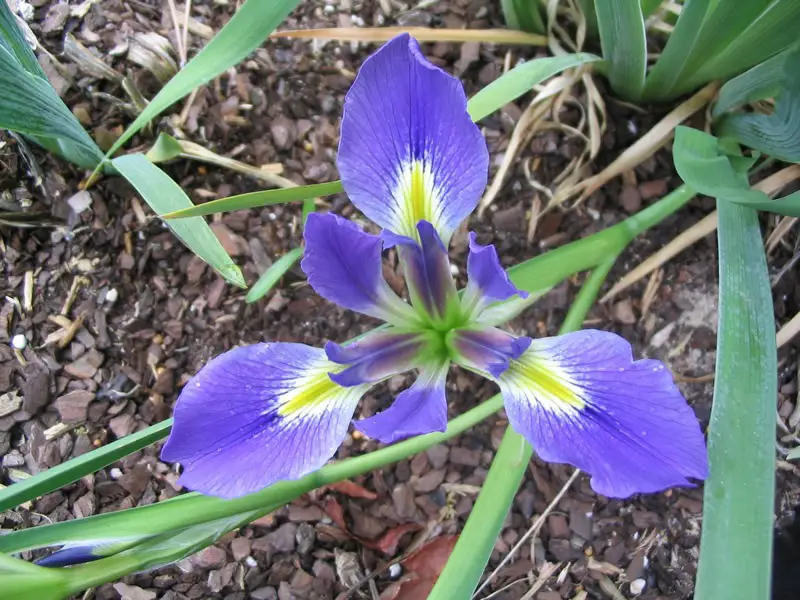
Iris brevicaulis ‘Zigzag’ is a species iris native to the swamps and wet meadows of North America. It gets its name from the distinctive zigzag pattern of its flower stems. The blooms feature arching violet standards and rich purple falls adorned with yellow signals. The bright green sepals add another layer of color, enhancing the overall beauty of the flower. Standing at 8 inches to 1 foot tall, ‘Zigzag’ is a compact iris that thrives in wet conditions.
This cultivar grows best in full sun and is hardy in USDA zones 4-8. While it originates from wild, wetland regions, it adapts well to more controlled landscape settings. ‘Zigzag’ has a unique personality, with its foliage sometimes taller than the flower stems. It can be a striking addition to a water garden or any moist area in your landscape.
To grow this iris successfully, plant it in moist, well-drained soil, and ensure it gets enough sunlight. Its unusual flower structure and vibrant color make it a wonderful choice for naturalizing or adding interest to a damp area in your garden.


